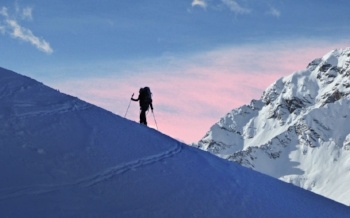What are the Best Snacks for Backcountry Skiing and Riding?
 Go further, ride better, and have more fun by using science to optimize your cold-weather fueling strategy.
Go further, ride better, and have more fun by using science to optimize your cold-weather fueling strategy.
It’s an undeniable fact: winter backcountry activities require a lot more calories than summer ones. But fill up your ski pack with snack cakes and whatever else happens to be in your pantry, and you might not like the results.
Better idea: Use the power of science to optimize your snacking strategy and make the most of your powder days. We interviewed nutritionists, chefs, and guides to find out what snacks are best for backcountry touring.
Pack foods that don’t freeze or squish.
There’s nothing worse than trying to gnaw your way through a frozen Clif Bar on a chilly day. Charlotte Austin, an international mountain guide and alpine climber, carries packets of energy gel and nut butter in the chest pocket of her parka. “I often instruct clients to carry snacks on their bodies instead of in backpacks,” she says. “Body heat keeps foods warm, and you’re more likely to consume the calories you need if they’re easy to access.”
Outdoor food doesn’t have to mean bars and gels, either. Jono Stevens, the founder of Cab9 Snowboard School in Meribel, France, reminds his clients to “bring some local cured meat and cheese to add to the experience.”
Alternatively, pack foods that get better when they’re frozen. “Sometimes I keep a bag of Skittles in an outside pocket,” says Jackson-based ski guide Richard Morse. “They freeze in the cold and make a great treat.”
Start eating before you start working.
If you feel dizzy, nauseous, fatigued, or experience muscle weakness or blurred vision, then you might have low blood sugar. The best way to prevent low blood sugar is to eat 3-4 hours before you begin touring. Taking in a carbohydrate dense meal before exertion will top off your muscle glycogen stores so you have plenty of energy to burn.
Starches and sugar are good sources of carbs. “Dried fruits are good sources of sugar and bananas actually have a decent amount of starch, says Daniel Freidenreich, Professor of Health & Exercise Science at Rowan University. “People can also make homemade fruit leathers on a food dehydrator. Freeze-dried corn is a good source of starch, but still has a nice sweet taste for palatability.”
Keep up the pace once you’re on the trail or skin track: A study of NOLS participants published in Research in Outdoor Education concluded that outdoor recreationists should eat small bites every 15-20 minutes during exercise, and consume a snack 20-40 minutes after exertion when their cells are most open to tissue repair.
Freidenreich clarifies that skiers should focus on carbs during hard exercise like steep uphills. “Protein and fat should be saved for meals during rest breaks,” he says.
Remember the 4:1 carb-to-protein ratio.
Carbohydrates give you energy while protein builds and repairs body tissues (like skin, bones and muscles) that get broken down over the course of a long tour. Eating the two in the proper ratio will keep you energized without weighing you down.
It’s easier to stick to the 4:1 carbohydrate to protein ratio if you make your own snacks. The Executive Chef of Killington Mountain School, Rhonda Benoit, says that she recommends “slow-burning fuel like granola or oatmeal” to athletes on the go.
Julia Mallon Delves, the founder of Trailside Kitchen, suggests portable meals like quinoa patties, and adds that meat won’t go bad quickly in cold weather. “If someone is concerned with food going bad, a dry-aged salami, as well as an aged hard cheese, are both shelf-stable and can be eaten easily with a MunkPack or similar oatmeal squeeze pouch for complex carbs,” she says. “If frozen food is a concern, slice the cheese and salami into bite sized pieces at home before leaving so that it warms up between your hands faster outside.”
Read the full story here.
Topics:

